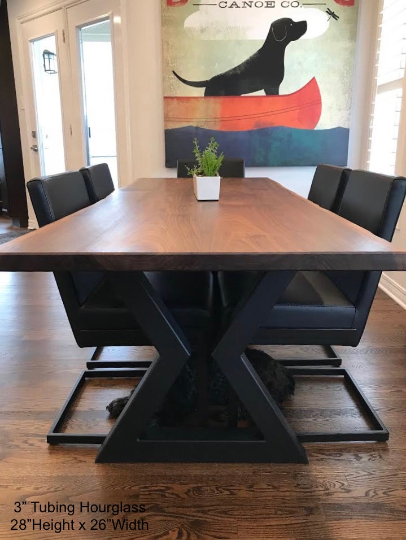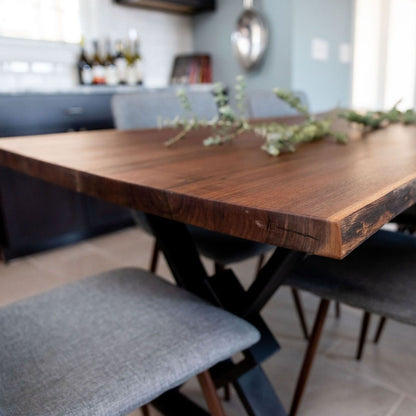Add Charm and Elegance to Your Space with Distinct Dining Room Table Legs
Add Charm and Elegance to Your Space with Distinct Dining Room Table Legs
Blog Article
From Typical to Modern: Locate the Perfect Eating Room Table Legs for Your Style
The choice of dining-room table legs plays an essential role in specifying the total character of your room, connecting the space in between typical craftsmanship and contemporary visual appeals. While timeless layouts such as cabriole and turned legs stimulate a feeling of ageless class, modern styles like hairpin and geometric choices offer an opportunity for striking aesthetic interest. Assessing the best balance between these styles needs a nuanced understanding of your existing decor and individual taste. As you take into consideration these elements, the inquiry continues to be: just how can you flawlessly integrate these diverse leg styles to produce a harmonious dining experience?
Comprehending Table Leg Styles
The range of eating space table leg styles can dramatically influence both the aesthetic appeals and capability of the room. Each leg design adds unique aesthetic components and practical attributes, accommodating varied design preferences and use needs. Recognizing these styles is essential for picking the appropriate table that straightens with your total interior decoration vision.
For example, conical legs provide a clean, classic appearance that can boost a room's elegance, while stand bases provide security and make best use of legroom, making them ideal for smaller sized spaces. Barrette legs, a trademark of mid-century modern-day layout, introduce a commercial style, permitting a ventilated, open feel. In a similar way, trestle legs stimulate rustic charm, providing robust support and a sense of timelessness.
Furthermore, the selection of materials plays a substantial function. Wood legs can bring heat and structure, whereas metal options usually convey a streamlined, contemporary ambiance. Eventually, comprehending table leg designs is crucial for producing a natural dining location that reflects personal style while guaranteeing functionality and comfort. By attentively taking into consideration these aspects, you can improve both the practical and aesthetic allure of your eating space.
Standard Table Leg Options
When choosing dining room table legs, conventional options commonly personify classic sophistication and craftsmanship. These styles mirror an abundant heritage and a commitment to top quality, making them excellent for those that appreciate timeless visual appeals.
One of one of the most iconic standard leg designs is the cabriole leg, identified by its stylish rounded shape. This layout commonly includes ornamental makings and is most frequently found in Queen Anne and Chippendale furnishings. One more prominent choice is the transformed leg, which flaunts a collection of smooth, rounded shapes that offer a timeless appearance while keeping stability.
Furthermore, the straight leg, while straightforward, provides a basic and strong structure that can mix flawlessly with a selection of tabletop designs. For those drawn to ornate detailing, claw-and-ball feet legs stimulate a sense of splendour and can act as a sensational focal point in any type of eating area.
Lastly, pedestal bases, although not purely legs, offer a different standard option that allows for sufficient legroom and can be magnificently carved. Each of these standard leg styles adds to the general ambiance of a dining room, marrying feature with aesthetic allure.

Modern Table Leg Styles
Modern table leg designs provide a diverse variety of styles that highlight clean lines and ingenious products. These layouts typically focus on capability while serving as striking prime focus within an eating area. Minimalist aesthetic appeals prevail, with legs crafted from products such as steel, glass, and engineered timber, which contribute to a contemporary and airy feel.
One prominent design is the barrette leg, identified by its slender, tapered framework that provides security without frustrating the table top (dining room table legs). This style is commonly link located in mid-century modern furnishings and can easily enhance numerous eating table forms. Another fad is using geometric shapes, where legs might take on angular or asymmetrical forms, including visual interest and a touch of virtuosity

Blending Styles for One-of-a-kind Spaces
Often, home owners seek to produce special dining rooms that reflect their personal style by blending various layout aspects. This approach allows for the incorporation of diverse visual appeals, resulting in an unified yet distinctive atmosphere. Matching a rustic wood table with streamlined, contemporary steel legs can create a captivating comparison that boosts the room's overall charm.
Additionally, incorporating vintage table legs with contemporary tabletops can stimulate a sense of history while keeping a modern sensibility. Such combinations not only display private taste but additionally motivate creativity, enabling house owners to curate an area that really feels both personal and inviting.
Color plays a vital function in this mixing procedure; choosing table legs that complement or comparison with the existing color design can improve visual passion. For instance, whitewashed legs can soften the daring of a dark table surface area, creating a balanced aesthetic.
Tips for Choosing the Right Legs
Choosing the right table legs is crucial for accomplishing both functionality and visual allure in your dining space. Begin by thinking about the total style of your space. Standard setups take advantage of legs that include complex makings or transformed layouts, while modern areas might ask for streamlined, minimalist designs.
Next, assess the height and stability of the legs. dining room table legs. Standard continue reading this table range in between 28 to 30 inches in elevation, so ensure the legs complement this measurement for comfort. In addition, robust products, such as hardwood or metal, can improve stability and durability
Evaluate the leg shape too-- choices consist of straight, tapered, or pedestal layouts. Straight legs use a timeless appearance, while tapered legs can add a touch of elegance. Pedestal bases give adequate legroom and are optimal for smaller spaces.
Verdict
In summary, picking the perfect dining space table legs needs cautious consideration of both modern-day and traditional styles. By harmonizing leg design, height, and product with the overall decor, a cohesive and welcoming ambience can be attained.
The range of eating space table leg designs can substantially affect both the looks and functionality of the room. Ultimately, recognizing table leg designs is vital for developing a cohesive dining location that reflects individual design while ensuring usefulness and convenience.One of the most iconic standard leg designs is the cabriole leg, defined by its stylish rounded form. Straight legs provide a timeless appearance, while conical legs discover this info here can include a touch of style.In summary, selecting the ideal eating space table legs needs careful consideration of both typical and modern-day styles.
Report this page